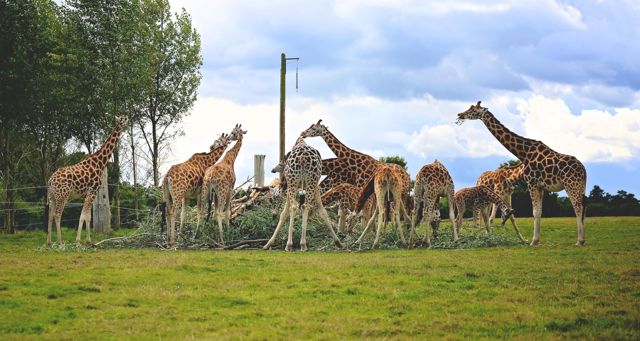
Overview
Woburn Safari Park is home to a large breeding herd of Rothschild's giraffe which can be seen at Giraffe Junction, in the Road Safari before entering the African Forest section. The herd is given the freedom to roam in their nine-acre exhibit.

All about us
| Distribution: | Kenya, Uganda, and southern Sudan. |
|---|---|
| Habitat: | Savannah, scrub, open acacia woodlands and subtropical and tropical grasslands. |
| Height: | Between 16 to 20ft |
| Weight: | Up to 1200 kg |
| Gestation Period: | Between 14 to 15 months |
| Lifespan: | 20 years |
| Threats: | Habitat loss and poaching |
About us
Scientific name: Giraffa camelopardalis rothschildi
They are housed at night however during the warm summer months our giraffe herd are able stay out in their large exhibit 24 hours a day (with access to their house). Woburn Safari Park has had tremendous success in the breeding of this Near Threatened subspecies of giraffe and we have played a fundamental role in the future captive breeding of this species and will continue to do so.

Rothschild's giraffe facts
There are various subspecies of giraffe and each have a different colouration and pattern of coat. Rothschild's giraffe have large chestnut coloured patches that are outlined with a broader white line then that of other giraffe subspecies and they have no spotting beneath the knees. They have a short brown mane that runs the length of their necks.
Giraffe are born with two horn-like structures on their heads, these are known as ossicones and grow to about 13 centimetres long; however Rothschild's giraffe have a further three horns, one small one on their forehead and a further small pair behind their ears. Females have thin ossicones with tufts of hair on the top, whereas males tend to have thicker horns that are bald on top, due to fighting.
Giraffe walk with both legs on one side lifted at the same time. This type of walk is known as a “pace” and allows longer strides and helps to conserve energy.
Giraffe are herbivores and they have a long prehensile tongue that is 45 centimetres long to help them to reach up into trees and pull down leaves. They are able to eat up to 134 kilograms of leaves a day and they will spend 16 to 20 hours a day feeding. They feed on the leaves and shoots of over a 100 different plant species however they will mainly feed on the leaves of the Acacia and the Combretum trees. Acacia trees have very large sharp thorns but due to the giraffe’s tough tongue and lips this doesn’t bother them. The giraffe in its habitat faces no competition for food from other species. Often males are seen feeding with their neck and head stretched vertically whilst females tend to feed on lower vegetation with their neck bent and head held down.
Giraffe do not migrate and this is due to the fact that they are able to extract all the moisture they need from their diet but they will drink every few days when water is available. Due to the enormity of the length of their neck they have valves in the blood vessels of their neck which stop the blood from rushing to their head when they bend down to drink. They also have a very efficient digestive system which allows them to absorb all the nutrients from their diet.
Male giraffe have to establish their dominance by ‘necking’. This is a behaviour in which two males stand side by side and swing their necks in order to thump their heads into the body of the other male. This form of sparring can be quite gentle if a dominant bull is with a young juvenile but with two strong dominant bulls it can become very aggressive. Serious injuries can be sustained and in some cases they can knock each other out.
Mating can occur throughout the year and after a gestation period of 14 to 15 months the female will give birth standing up to a single calf. The new born is usually able to stand 20 minutes after birth and will measure around 1.8 metres tall.
A few hours after birth, calves are able to run around and play however for the first two weeks of their life they will spend a lot of time lying down being closely guarded by their mother. The calf will gain an extra two metres in height during its first year and will be weaned from their mother at the age of one. Females will often remain nearby to their mothers for life but males at the age of three will join other bachelors where although they are able to breed it is unlikely they will get the opportunity to mate before the age of seven due to competition.
Giraffe are a very sociable species and they are not territorial. They will form loose herds that have no permanent members within variable home ranges. Adult females that have young tend to associate more with one another as the calves will tend to form crèches and stay close together. Males tend to leave their mothers at three years of age and they will usually form a roaming bachelor herd until they are dominant enough to breed.
Giraffe used to be hunted for their tails alone that were used as fly swats, good luck charms and thread for sewing! However their main threats now are habitat loss and poaching for their meat and hides.





